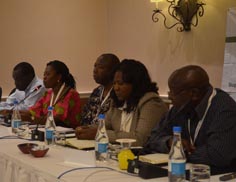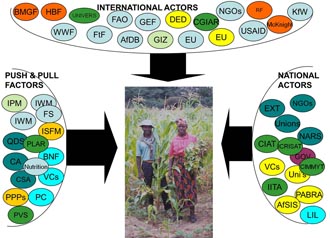Listening to presentations for almost a week at the Joint Pan-African Grain Legume and World Cowpea Conference early this year, it was clear that there a lot of efforts that are going on the African continent that are geared towards intensifying legume production for smallholder farmers in a sustainable way. However, a big question was still lingering in mind as to why smallholder farmers were still not catching the ‘fire’ of all these efforts? In almost all the presentation, the picture of low productivity was crystal clear – smallholder grain legume productivity still remains very low – yields achieved of less than 1 ton/ha compared with potential yields of 2-3 ton/ha. And this was also true for cereal crops. On the final day of the presentations, a couple of slides by Prof. Ken Giller of Wageningen University in the Netherlands drew my attention, perhaps because they resonated with my own experience in trying to promote soil technologies among smallholder farmers to improve crop productivity. His slides showed that the myriad of efforts by the practitioners are creating more confusion than the good they intended to achieve. The pictorial presentation of the efforts looked like a ‘spider web’ with a farmer in the middle as a ‘spider’.
|
Pictorial presentation of efforts by the diversity of actors and factors involved in improving farmers’ crop production (Figure Giller, 2016) |
It is therefore true that much soil and crop management knowledge relevant to agricultural production transformation has been generated through decades of research and investment, but the yield for most crops have remained stuck at less than 30% of the yield potential for most African countries (http://www.yieldgap.org). This scenario is mainly a function of poor adoption of good agronomic practices (AGRA, 2013), as a result of limited integration and flow of available information across formal and informal institutions and various levels of the agricultural value chain. Often this leads to duplication of research efforts, dissemination of conflicting messages and limited application of the right knowledge in making decisions (Toenniessen et al., 2008). |
Often this leads to duplication of research efforts, dissemination of conflicting messages and limited application of the right knowledge in making decisions (Toenniessen et al., 2008). The resulting confusion leads to either limited uptake or inappropriate implementation of good agricultural practices. Further, the existing information is often poorly synthesized and interpreted for local application and remains dispersed across multiple locations, with scientists and institutions. For as development of good agronomic practices requires information integration relevant to soil types, inherent soil fertility status, fertilizer application (type and rates), crop varieties, agro-climatic zones, socio-economic implications, legal and regulatory structures and the input-output market environment.
In trying to bring a degree of normality to the prevailing atmosphere, AGRA in the last 3 years has been supporting Country Soil Healthy Consortia that bring together soil scientists, agronomists, plant breeders, seed scientists, policy experts, extension workers, communication experts, and other relevant stakeholders drawn from across regions of the country. Through the consortia they answered questions such as who is doing what and where?, what is working?, what are the lessons learnt?. This has led to harmonizing of agricultural messages going to the farmers and complementarity of the efforts has started showing positive fruits in a number of countries. Again, in an effort to scale up integrated soil fertility management practices using a value chain approach, AGRA recognized the need for partnerships to help farmers’ access knowledge, farm inputs and finance to purchase them, and output market incentives. It’s very unlikely that one institution or project could provide all the services on the value chains and therefore coordinated multi-stakeholder partnerships within and between projects become critical.
The Legume Alliance supported by N2Africa in Tanzania (see Podcaster 33), which recognizes that, when efforts of various partners are joined and when partners can learn from each other, there are high chances to meet the ultimate goal of transforming smallholder agriculture is another good example of bringing normality to the prevailing atmosphere. Needless to say that the smallholder farmers’ dream of achieving food security and increasing household income through agriculture will also come true when efforts are coordinated and harmonized. As the African Proverb say ‘if you want to go fast, go alone; if you want to go far, go together’. Intensifying legume production for smallholder farmers in a sustainable way will require joint and well-coordinated efforts.
Rebbie Harawa
Member of the N2Africa Advisory Committee, representing AGRA
AGRA (2013). Africa Agriculture Status Report: Focus on Staple Crops. Nairobi, Kenya. Issue 1. Toenniessen G., Adesina, A. and Devries, J. (2008). Building an Alliance for a Green Revolution in Africa. Ann. N.Y. Acad. Sci. 1136: 233–242. Giller, K.E. (2016). Thematic plenary session: Grain legumes nitrogen fixation and contribution to sustainable intensification. Pan-African Grain Legume & World Cowpea Conference, Zambia. |
 |
Impressions of the plenary session and panel discussion with Theresa Ampadu-Boakye speaking (Photo Edward Baars, 2016) |
|
All presentations delivered as keynote plenary, plenary, and topical oral sessions during the Pan-African Grain Legume & World Cowpea Conference can be downloaded from http://gl2016conf.iita.org/index.php/presentations/. |

